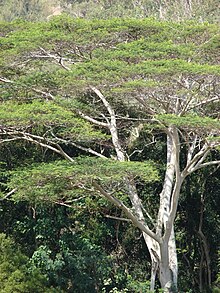Accepted scientific name
An accepted scientific name (in English some authors use correct name in botany , valid name in zoology ) is the only correct scientific name in biology according to the International Code of Nomenclature for algae, fungi, and plants (ICN) or The International Code of Zoological Nomenclature (ICZN), which is to be used for a specific taxon if this taxon has the mandatory description , position and rank .
Regulations
Determining the accepted scientific name is a complex process. The name must validly published ( English validly published ) be a procedure that is not described in less than 16 articles of the ICN. He must also ( "legitimized" English legitimate to be), which provides some additional requirements for the name. If there are two or more legitimate names for the same taxon (with the same description, position and taxonomic rank), then the accepted scientific name is the one that enjoys priority, i.e. the one that was published first (priority principle), although names can also be preserved , in case they are widely used. Valid published names that deviate from the accepted scientific name are referred to as synonyms . Because taxonomists can contradict the description, status, or rank of a taxon, there can be more than one accepted scientific name for a particular taxon. These can also be referred to as synonyms.
The accepted scientific name has only one correct spelling, which is generally the original spelling (although various limited corrections are allowed). Other spellings are called the orthographic variant .
Example botany
Different taxonomic viewpoints can easily lead to different accepted scientific names. The earliest published name for the fastest growing tree in the world is Adenanthera falcataria L. The "L." stands for Carl von Linné , who was the first to publish this name in a valid way. Adenanthera falcataria is therefore one of the accepted scientific names for this species of plant. However, there are other accepted scientific names based on other taxonomic approaches.
- This species can be classified in the genus Albizia , as Fosberg was the first to do. If this species is considered to be a member of this genus, then the accepted scientific name is the genus name followed by the earlier specific epithet , resulting in Albizia falcataria . This name could not be used if there was already a species with this epithet within the genus, thus creating an illegitimate duplicate. Since this is not the case, the accepted scientific name within this genus is Albizia falcataria (L.) Fosberg . " Fosberg " stands for the author who transferred the species to the new genus; "L." stands for the author of the basionym from which the new name was derived.
- This species can also be grouped into the genus Paraserianthes . Your accepted scientific name in this position is Paraserianthes falcataria (L.) ICNielsen .
- Within the genus Paraserianthes , this species is grouped in the section Falcataria . If the section is upgraded in rank and raised to the genus Falcataria , the accepted scientific name cannot be Falcataria falcataria , as would be expected, since according to the rules of the botanical code (not those of the zoological) names with the same word in the genus and species - Epithets ( tautonyms ) are excluded. An alternative basionym must be found or a completely new name created. The accepted scientific name is Falcataria moluccana (Miq.) Barneby & JWGrimes .
The four names Adenanthera falcataria , Albizia falcataria , Paraserianthes falcataria and Falcataria moluccana are accepted provided that this plant species is grouped into the respective genus. Which is the "right" name is a taxonomy problem , not a nomenclature problem . Hence, this tree will have different accepted botanical names for different people who use it.
See also
- International regulations on nomenclature
- International Plant Names Index
- International Association for Plant Taxonomy
- Author abbreviations for botanists and mycologists
- Binary nomenclature
- Nothospecies
Individual evidence
- ↑ a b c d e f g h i J. McNeill, FR Barrie, WR Buck, V. Demoulin, W. Greuter, DL Hawksworth, PS Herendeen, S. Knapp, K. Marhold, J. Prado, WF Prud'homme van Reine, GF Smith, JH Wiersema & NJ Turland (Eds.): International Code of Nomenclature for algae, fungi, and plants (Melbourne Code) adopted by the Eighteenth International Botanical Congress Melbourne, Australia, July 2011 (= Regnum Vegetabile), Volume 154. ARG Gantner Verlag KG, 2012, ISBN 978-3-87429-425-6 .
- ↑ N. Turland: The Code Decoded: A user's guide to the International Code of Nomenclature for algae, fungi, and plants (= Regnum Vegetabile), Volume 155. Koeltz Scientific Books, 2013, ISBN 978-3-87429-433-1 .
swell
- M. Barkworth: Botanical Nomenclature (Nomenclature, Names, and Taxonomy) . University of Utah. 2004. Archived from the original on July 20, 2011. Retrieved on February 20, 2011.
